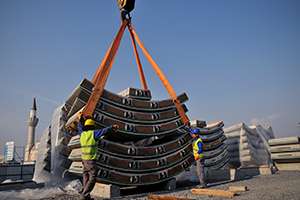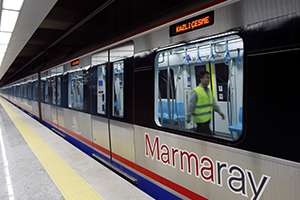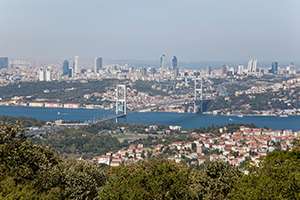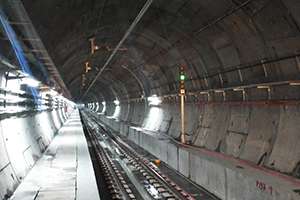Engineers find way to build a tunnel under the Bosporus Strait

The two young women are ready for the big moment. With their backs turned toward the rails, they're holding their cell phones in position and standing arm in arm on the platform at the Üsküdar train station. As the İstanbul Banliyö Trenleri, a commuter train with red and blue stripes, pulls into the station, they snap a picture. A few minutes later it will appear on Facebook with the caption "First time MarmaRay Cool!!!!"
Harun Oruç is also holding his smartphone, but he's not paying attention to the incoming train. He's reading his e-mails. When the doors of the silver train glide open, he looks up and steps into the fully occupied car. Oruç, a 32-year-old patent lawyer, commutes almost daily from Asia to Europe and back again. His office is located on the eastern side of the strait, and some of his clients are on the western side. "It used to take me at least an hour to get from one side to the other," he says. "There were only two ways to cross the Bosporus: the ferry or the bridges. You get stuck in traffic even on the way to the ferry, and the three bridges are permanently congested." Oruç, who would often arrive for his appointments stressed out and with his suit wrinkled, says, "I used to really feel that I was traveling from one continent to another. Today I step into the train in Asia and—zip!—five minutes later I'm in Europe. Fantastic!"
Earthquake-Proof Tunnel. About 15 million people live in Istanbul, a 2,600-year-old metropolis that straddles the Orient and the Occident. About a third of them travel across the Bosporus every day for work or other reasons. Since October 29, 2013, they have had an alternative: the Marmaray Tunnel, which was opened just in time for the 90th anniversary of the Republic of Turkey. The government terms it "the tunnel of the century," and newspapers call it "the new Silk Road of the 21st century" or even "China's nonstop connection with Western European markets." The name of this commuter route, which will be the heart of a future network of long-distance and freight routes, combines the words "Marmara" and "ray," the Turkish word for "rails."
Already some 160 years ago, sultans were dreaming of a tunnel under the Sea of Marmara. But engineering could not cope with the special challenges of the Bosporus until the early 21st century. Not only is the strait characterized by powerful currents that run in opposite directions deep under the water's surface, but the seafloor is at risk of earthquakes. As a result, the underground tunnel had to be built to withstand earthquakes with a Richter magnitude of nine.

What is more, shortly after construction work began, the Roman Empire struck back—with ships, anchors, leather sandals, hairbrushes, and candleholders. Archaeologists found thousands of objects that they identified as relics of Constantinople. The skeletons they excavated are even regarded as evidence that people lived in Istanbul over 8,000 years ago. These discoveries delayed construction work for years.
Engineer Javier Raposo and his colleagues from Siemens Rail Automation in Istanbul thus had to work very quickly during the final phase of construction. They had to make sure that the system, in which commuter trains would glide through the undersea tunnel at two-minute intervals, would enter service in time for the 90th anniversary of the Republic of Turkey.
Today, some 75,000 people are transported every hour in both directions when the system is working at full capacity. That adds up to a million passengers per day—one fifth of Istanbul's total daily traffic.
The Siemens team was able to install the complete signaling and control technology, ranging from individual transmission cables to a complex operating system, only after the tunnel was completed and the rails had been laid. "The timeframe kept shrinking," Raposo recalls. Six months were initially planned for construction of the 13-kilometer stretch between the Kazlıçeşme and Ayrilikçeşme me stations, but ultimately that period was reduced to only two months. "That was a challenge, but we met it successfully," he says.
Moving-Block System. The short intervals between trains are made possible by a combination of several systems. These systems ensure that everyone involved—the drivers, control center personnel, and the trains themselves—has the same updated information. For this purpose, the trains are connected to the signaling system via radio. A train control system (Trainguard Sirius CBTC) that is installed in the infrastructure as well as in the trains, collects precise information concerning the location of individual cars. When a train travels through the tunnel, it passes one virtual block after another and continuously reports its position via radio to the block processors, which are connected with the electronic interlockings. The trains then receive instructions telling them how fast they can travel in which blocks. In this "moving block system," balises—small plates equipped with transmitters and receivers and embedded in the tracks—register a train's position and speed. In parallel, the exact position of every train is transmitted to a control system that monitors the traffic flow and guides it if necessary.

"The crucial feature of our train control system is that it knows what conclusions must be drawn on the basis of the information," Raposo explains. "It always knows how fast each train is traveling, when it stops, and when it starts up again. It knows the positions of the individual trains, and it recalculates the driving speed and braking distance for all the CBTC trains that are on a given route. The driver authorizes the train to run in automatic mode after each stop at a station and supervises the closure of the passenger doors." In this way, every train is automatically adjusted to the speed and position of the others.
But the system can do even more. It can save people's lives. Sensors sound an alarm if the earth quakes or water begins seeping into the tunnel. In such cases, trains automatically stop before entering the 1.4-kilometer section of the tunnel that lies under the seafloor, and the system closes the gates at both ends of the section. "The train control system also knows whether there are still trains in this section," Raposo explains. "The gates close only after all trains have left this critical section."

The train in which Harun Oruç is traveling has now passed the Bosporus, and five minutes later it stops at the Yenikapi station. Before the door opens, Oruç glances at his reflection in the train window and adjusts his suit jacket. As he steps out of the glistening rail car, he says, "There's yet another great aspect of the Marmaray Tunnel. I've traveled from Asia to Europe, and there's not a single wrinkle in my suit." He winks before disappearing into the crowd of passengers.
Provided by Siemens





















